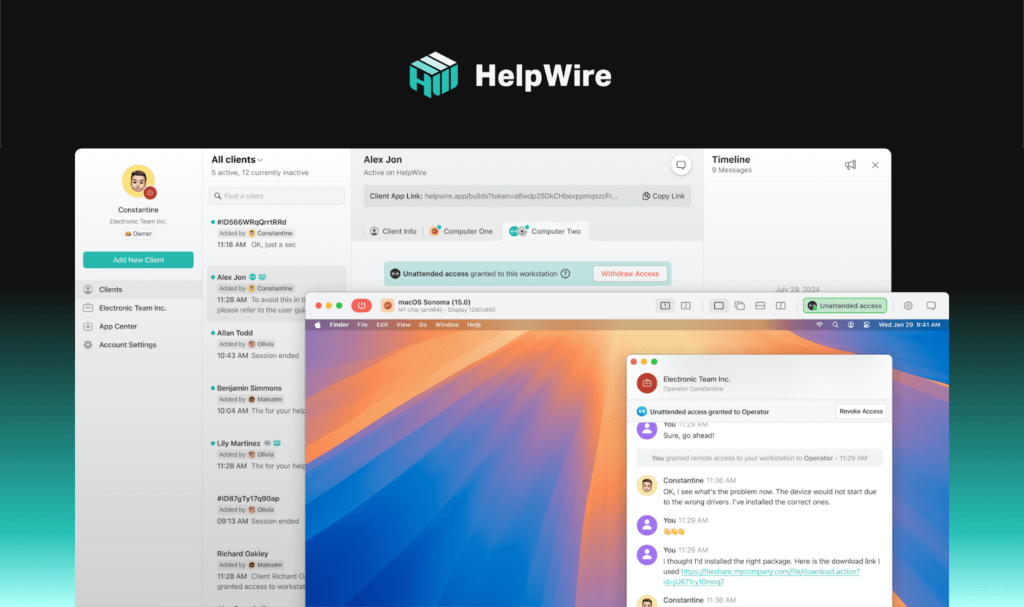Best Lightweight Remote Support Tools: How HelpWire Fits the Category

We’ve all been there. A family member calls in a panic because something on their computer isn’t working, or your freelance client needs urgent help just before a deadline. In moments like these, remote support software is a lifesaver.
But here’s the catch: many traditional tools are heavy, require complex installations, or demand admin rights, things you don’t have time for when the clock is ticking. That’s where lightweight remote support tools come in.
In this article, we’ll explore why lightweight software matters, look at real-life situations where it makes a difference, compare a few popular options, and see how HelpWire fits right into this category.
Table of Contents
Why Lightweight Tools Matter
Lightweight doesn’t mean “less capable.” It means practical: tools that work with you, not against you. And if we’re honest, we’ve all run into those apps that make us spend hours watching tutorials just to figure out the basics. With lightweight tools, the opposite is true: they’re easy to use and easy to understand. You don’t need a tech degree to operate them, and in the case of HelpWire, the interface is so intuitive that most people can get started right away without instructions.
- Ease of use – Quick install, no complicated setup.
- Affordability – One of the biggest advantages of lightweight remote support tools is cost. Unlike premium platforms such as TeamViewer, where businesses often end up paying for a long list of advanced features they rarely use, these leaner solutions keep things simple and budget-friendly. In many cases, they’re free or come at a fraction of the price, making them especially appealing for freelancers and small businesses.
- Accessibility – Because they run smoothly even on older laptops and weak Wi-Fi, lightweight solutions don’t leave anyone behind.
- Security – Lightweight doesn’t mean “less secure.” On the contrary, many of these tools (including HelpWire) use end-to-end encryption and session permissions to ensure support occurs safely. They’re designed to protect both the person giving help and the one receiving it.
When technology should be helping you, not slowing you down, lightweight tools prove their worth by being simple, fast, and trustworthy.
Real-Life Scenarios Where Lightweight Remote Support Helps
- Helping parents or grandparents – Your mom calls, saying “the screen went black” right before she’s supposed to join a family video call. Instead of trying to explain over the phone where the “Settings” button is, you just send her a quick link, hop on her screen, and she’s smiling on Zoom five minutes later.
- Small-Scale Remote Support Providers – Freelancers and independent consultants need a fast, low-friction way to access client machines—often ad hoc and across mixed operating systems—without dealing with heavy installs, licensing hurdles, or complex infrastructure. Because many clients aren’t technically savvy, even small barriers like account creation or bulky installers can cause unnecessary friction. Meanwhile, enterprise-grade tools are overkill: too complex, costly, and heavy for solo operators or small freelance practices.
- Small businesses – A bakery’s POS system freezes at 8 a.m.—the busiest time of the day. Customers are lined up, the staff is stressed, and every second feels like forever. With a lightweight support tool, the tech jumps in remotely, gets it running again, and the croissant line keeps moving.
- Emergency fixes – It’s late at night, and your coworker calls in a panic: tomorrow’s presentation file is corrupted. Instead of rushing over, you log in remotely, fix the slides, and everyone gets to sleep a little easier.
Examples of Lightweight Remote Support Tools
Here are a few widely used options:
- Chrome Remote Desktop – Simple and browser-based, but limited in features.
- AnyDesk (portable version) – Fast and portable, though the free version has restrictions.
- Supremo – Affordable and easy to use, but not as sleek in design.
- Jump Desktop – Reliable on multiple platforms, but can feel heavier than others.
- HelpWire – Browser-based, user-friendly, and designed for speed and simplicity.
Each has strengths and weaknesses, but all aim to reduce friction in getting connected.
Lightweight Remote Desktop: Key features & How HelpWire Fits In

HelpWire combines native apps for performance with a web dashboard for convenience, making it a strong fit for freelancers and small support providers who value speed and simplicity.
Instead of bloated toolsets, it focuses on the features that matter most in real-world support:
- Quick setup & easy join – A small installer and one-click session links mean clients are ready to connect in under a minute, no accounts required.
- Multi-screen view & file transfer – See every monitor in complex setups and move files with drag-and-drop for faster troubleshooting.
- Stable on weak connections – Adaptive streaming ensures smooth sessions even on patchy Wi-Fi or slower broadband.
- Straightforward controls – An uncluttered interface with simple session options keeps things intuitive, even for non-technical users.
- Built-in security – Encrypted connections and permission-based access provide peace of mind without extra configuration.
In practice: Whether restoring a frozen checkout system, pushing a quick patch, or guiding a client through setup remotely, HelpWire shows how a lightweight tool can stay fast, practical, and effective without sacrificing what matters.
Conclusion
Lightweight remote support software isn’t just a convenience—it’s often the only realistic solution when time, bandwidth, or technical skills are limited.
From family emergencies to small business troubleshooting, these tools save time, reduce stress, and keep things running smoothly. Among them, HelpWire shows how a thoughtfully designed, browser-based tool can make remote support fast, efficient, and accessible to everyone.